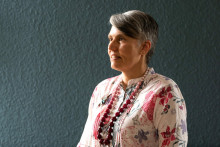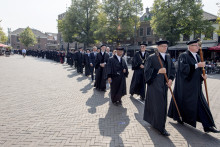In Kigali, the main focus was on the hydrofluorocarbons (HFCs). Guus Velders is regarded as an expert in the field of HFCs. 'It is a greenhouse gas that is used, for example, in refrigerators and air conditioning systems,' he says. HFCs were regarded as the solution for the CFC (chlorofluorocarbon) issue, as CFCs damage the ozone layer. HFCs became popular around 1995 as an alternative for CFCs. But HFCs turn out to be not quite as harmless as initially assumed. They do not damage the ozone layer, but they do absorb the infrared radiation in the atmosphere and thus contribute to global warming’.
And that is a problem, as has been proven by Velders and his American colleagues. In 2009, they published an article in which they concluded that the 'new' HFCs significantly contribute to global warming. 'An unintended, but significant side effect. Our calculations showed that, by 2050, they will contribute to global warming by 10% to 20%,' Velders explains. 'In the developing countries, there is a huge demand for cooling agents for air conditioning systems and refrigerators.'
Air quality research
Guus Velders (53) studied Applied Physics at the University of Twente and received his PhD degree in 1992 at the department of Chemical Physics. He then worked for the Royal Netherlands Meteorological Institute (KNMI), where he had also done research on the emissions of air traffic during his military service. A year later he joined the National Institute of Public Health and Environmental Protection (RIVM). He is now head of the Air Quality division. His group registers emissions and researches ways to improve air quality.
Proposals
Back to Rwanda, where Velders was staying to attend the climate summit. In Kigali, four proposals to get rid of HFCs were on the table. 'The summit started on Sunday,' Velders says. 'On Tuesday, after the negotiations among the policy-makers, two proposals were left: the western countries wanted to ban HFCs quickly, but a group led by India wanted to follow a slower path.'
Velders did not attend the negotiations himself. 'They took place behind closed doors.' But in the corridors he passed a room where the European Commission kept the compromise proposal of the developing countries. 'I entered the room and took a picture with my phone,' he says.

Sobering
The next Thursday, the responsible ministers came to Kigali and they expressed their political positions. A process described by Velders as 'sobering'. 'Nobody seems to be willing to move. If you are familiar with the proceedings, you know that these are negotiations. Countries want to be compensated; they demand money.' In a small room, Velders found a compromise proposal drawn up by the western countries. 'I quickly took some notes. Not much later, I received a text message with the figures of the compromise proposal.' Velders entered the figures in a model on his laptop. It turned out that, over a period of one hundred years, the impact of the two proposals on global warming was almost identical. 'That night, a journalist from Nature called, and I told him about my findings,' he continues. 'Publication in Nature opened the way for an agreement that was acceptable for the India group.'
End point
The success of Kigali does not stand on its own. It is the 'end point' of extensive negotiations, lobbying and global developments. ‘The topic had been discussed since 2009,' Velders says. But the real turning point did not come until 2013. During the G20 summit, President Obama managed to convince countries such as China and India, which had not wanted to change their position, to support the phasing out of HFCs. 'This was supported by the fact that, one year later, Europe and Japan had already made considerable progress and the United States had also taken action. That paved the way for the success of Kigali, where HFCs were included in the Montreal Protocol, an international treaty drawn up to protect the ozone layer.'
700 million air conditioners
The expectation is that, by 2030, another 700 million air conditioning systems will have been installed. According to Velders’ calculations, this results in a temperature increase of 0.3 to 0.5 °C in 2100. As a result of the Kigali treaty, this increase will be limited to 0.06 degrees. This is to be achieved by a reduction of HFCs by 80% to 85%.
Impact
Velders is aware that a scientist rarely has such a big impact on policy, especially in a field that does not have his full-time attention. 'It is really a hobby that got out of hand,' he laughs. 'I have been working on this subject since 2007, and together with my American colleagues I have built an expertise that is unique.' He doesn't mind that it takes up much of his evenings. 'It gives me energy that I can contribute something to the world we leave behind. To contribute scientific, not political information that allows good political decisions to be taken.'
With the new president Trump, who is not particularly in favour of climate policy, the course of the United States is about to change. Is Velders concerned about this? 'No, not at all, actually. We have started on a path which can no longer be reversed. Whatever Trump says, the industry has already embraced the opportunities offered by the elimination of HFCs. There is money to be made with the development of alternatives.'
Three time frames
The US and other rich countries have committed themselves to starting with the reduction of HFCs in 2019. By 2036, emissions must have been reduced by 85%. China and most of the developing countries will start with measures to reduce emissions in 2024. India, Pakistan, Iran, Iraq and the Gulf States will not start until 2028. India and Pakistan have asked for an additional two years, claiming that their economy needs more time to grow.
This story can also be found in our latest Science Magazine. See the magazine online or grab a printed copy on the campus.







